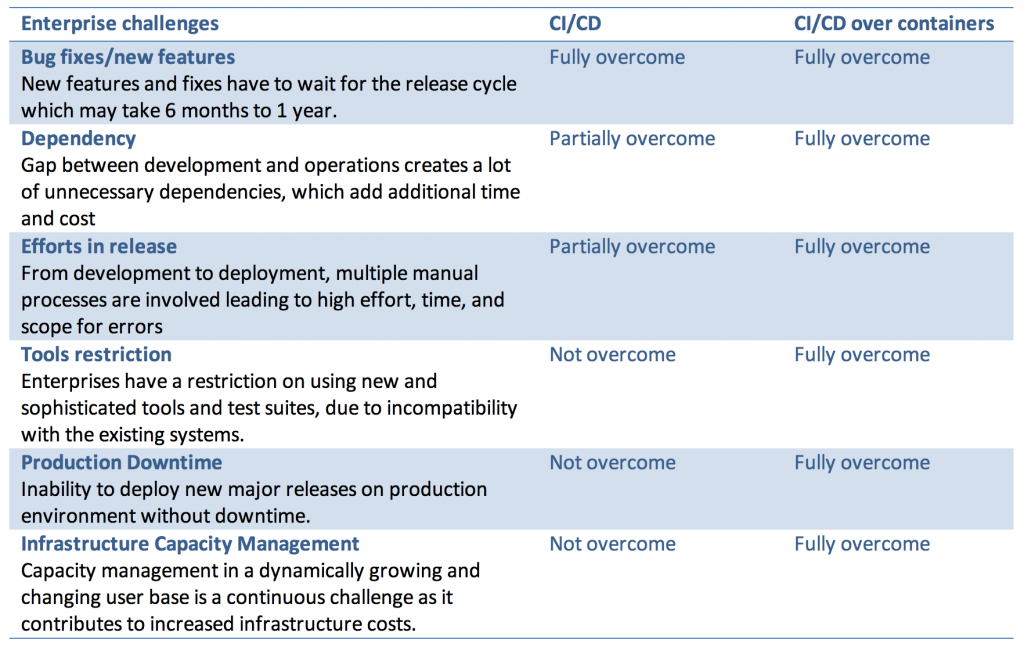Using CI/CD Over Containerization to Drive Down Pre-Production Costs
Let’s look at traditional, linear application development process. It follows a sequential methodology, which means the bugs that are present in the current build will have to wait for the next build to be addressed. The advent of continuous integration and continuous delivery (CI/CD) has revamped the traditional application development process in a drastic way. The CI/CD-based process involves DevOps—the paradigm shift that brings developers, QA engineers, and operations managers together on one platform. It generates frequent feedbacks on every stage and follows an automated process from build and test to production environment.
Can the CI/CD based application development process be improved even further? The most modern approach is to use containerization to bring even more flexibility and benefits, such as the frequent and faster deployment of software releases and cost reduction, to CI/CD-based application development. Let’s see how this works.
What Is a Container?
When we talk about containerization, we need to also understand how virtualization works and how it is used to deploy distributed applications. Virtualization is designed to take an application and run it on any environment without having to modify its code or redevelop it. However, virtualization has a major disadvantage. Imagine the case of Windows: It occupies a large storage space and has many dependencies. Hence, creating a virtual machine for it takes time and a lot of resources. Sometimes this heavy resource requirement could be a trade-off for the application deployment.
Containers overcome this challenge by creating a very lightweight virtual environment that contains only the specific runtime environment and dependencies of the application in question (the files, environment variables, and libraries). It doesn’t need the entire operating system to be running in the virtual machine. Containers can scale endlessly, be flexible, and run on any environment.
A few advantages of CI/CD application development and deployment over containers are following.
- Containers are a lightweight alternative to virtual machines, so the deployment is much faster.
- Ready-to-run portable software: Containers are a form of OS virtualization that includes just the minimum OS resources, memory and the services required to run an application or service.
- Faster and error-proof deployment: Removes all technical snags related to driver compatibility, library conflicts etc.
While CI/CD based second generation application development process has myriad advantages, let’s look at how the containers improve it further. Check out the table below to understand how containers address specific enterprise challenges.
 As you can see, several enterprise challenges, which are an obstacle on the CI/CD-based application development and deployment, are fully overcome with the use of containers.
As you can see, several enterprise challenges, which are an obstacle on the CI/CD-based application development and deployment, are fully overcome with the use of containers.
Recommended Features of CI/CD Over Containerization
Here are some recommended features for a CI/CD based solution that uses containerization:
- Agility: Microservices-based architectures help deliver patches and releases more frequently. In addition, containers help in frequent and fast deployment of releases.
- Portability: Container as a service (CaaS) makes code shipping very easy. Also, it provides high scalability. The containers can deploy applications without ever affecting the system, which means there is zero downtime for the production environment.
- Controllable: A portal shows the status of activities and utilization of resources. Containers provide one-click commissioning and decommissioning of the environment. Also, the adaptable CI/CD framework helps enterprises use any tool of their choice.
- Adaptability: There are APIs that make the framework adaptable to any tool, repository, test suite or deployment engine. So, the enterprises have the freedom to choose whichever tools they want to use.
- Automation: The CI/CD framework over containers can automatically build, package, and deploy applications. This also completely obviates manual errors.
Recommended Framework Supporting CI/CD Over Containers
Below is the structure of a CI/CD framework that automates every stage from development and test to production, while minimizing errors and delays in the process.![]()
Conclusion
As you can see, the CI/CD over containerization has several advantages over the traditional software development process as well as the CI/CD based software development process.
- Faster time to market: A typical CI/CD solution follows microservices architecture that gives approximately 18 percent reduction in time to market for new applications, which increases the revenue by 19 percent and delivery capability by approximately 21 percent.
- Optimum use of infrastructure: CI/CD over containers makes shipping of code easy. It enables enterprises to maximize their efficiency and minimize resource wastage. Also it achieves approximately 30 percent reduction in infrastructure usage from development and test consolidation to production.
- One-click infrastructure provisioning and decommissioning: CaaS features, such as portal view and one-click infrastructure provisioning and decommissioning, reduce the resource wastage as resources are created and decommissioned dynamically based on the need. This results in up to 50 percent reduction in overall use of virtual machines.
About the Authors
Pravin Dagdee
Pravin is Senior Director of Infrastructure Management at Prodapt. He is a seasoned IT delivery director with more than 25 years of experience in building and delivering infrastructure management solutions for top telecom companies in various geographies. Connect with him on LinkedIn.
Praveen C
Praveen C is Technical Architect of Delivery at Prodapt. He has over 15 years of experience in building cloud data center solutions for tier 1 & 2 telcos. His current focus areas are DevOps and automation. Connect with him on LinkedIn.
Vishwa Nigam
Vishwa Nigam is Manager of BI & Insights at Prodapt. He is an experienced business manager with a demonstrated history of building & delivering actionable insights on DevOps, IoT and robotic process automation. His areas of interest are analytics, process improvement, and business model innovation. Connect with him on LinkedIn.
Lenin Nair
Lenin Nair is Assistant Manager of Marketing at Prodapt, where he coordinates the marketing and publication activities. He is an experienced writer and tech enthusiast. Connect with him on LinkedIn.




